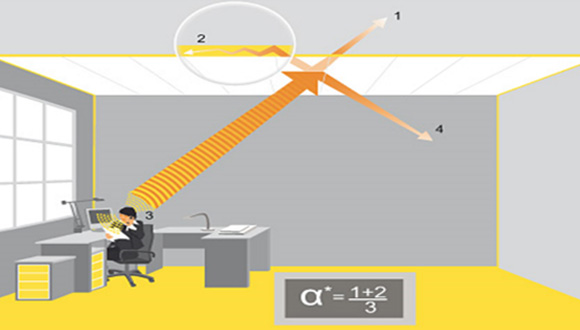
- Homeowners
- Professionals
- Products
- Back
- PlasterBoards
- Metal Framing & Accessories
- Jointing and Finishing
- Gypsum Plasters
- Ceiling Tiles
By material Type
By Category
- Resources
- About
- Careers
- FAQ's
The science and engineering of achieving a good sound environment within a building space.
Building acoustics design is achieved by following an “intelligent layout” where noise producing areas are separated from noise sensitive areas. Acoustics design should also ensure sound insulation between rooms and sound absorption of excess sound to improve communication and reduce noise related distraction.

Reducing sound transmission between adjacent rooms
Sound Insulation is the reduction of sound (decibel level) as it passes through a partition. A partition can be a wall, ceiling or floor. The passage of sound into one room of a building from a sound source located in another room or outside the building is termed ''sound transmission".
For good sound insulation, the partition must be capable of blocking airborne sound and the construction must ensure no gaps and leaks using which sound can travel around the partition.
STC or Sound Transmission Class is a single number rating given to partitions which indicate the degree of sound transmission loss offered. A higher STC corresponds to a greater degree of sound insulation.

Reducing noise within a room through absorbing
When sound meets a surface, a part of it is absorbed. The percentage of sound that is absorbed by a material is defined as the ‘Absorption Coefficient’ which is expressed on a scale 0-1. Sound absorption is important because it reduces sound levels inside a room.
Noise Reduction Coefficient (NRC):
Sound absorption of a material varies with the frequency of sound. Noise Reduction Coefficient is the mathematical average of absorption coefficient of a material at four frequency bands - 250, 500, 1000, 2000 Hz
The open plan office model has been widely adopted by companies in India and across the world. Although this new model creates an open work environment, it continues to face criticism regarding its acoustic qualities. Some advantages and disadvantages are:
Advantages |
|---|
|
Disadvantages |
|---|
|
Sound Absorption: Reducing excess noise within an office by using sound absorptive materials for internal surfaces and furniture. Reduced noise improves communication between employees and also reduces noise related distraction.
Sound Insulation: Reducing sound transmission through walls, ceilings, doors and windows is essential for privacy.
Zoning: Intelligent layout of an office space keeping acoustics in mind. Often, materials are not the solution but an intelligent layout is.
Drywall partition systems are highly suitable for indoor spaces. Some of the advantages of using drywall systems for internal walls are:
Even though concrete is better at blocking sound than Plasterboard, a drywall system is more effective than a solid concrete wall. How?
The drywall partition works on the mass-spring-mass system. As sound transmits through the partition, the change in medium (from Gypsum to air/Glass Wool to Gypsum) causes high transmission loss. Therefore, the sound transmitted onto the other side is much weaker.
The open plan office model is the most widely adopted office layout format. Most companies around the world are switching to the open plan model and around 73% of employees work in the open plan office environment (Sykes, 2004).
Surveys have shown that poor acoustics is the most frequent complaint by employees citing office noise as a major distraction to their work.
Several research studies have proven that office noise severely reduces an employee’s ability to complete cognitively demanding tasks.
Along with ventilation and lighting, acoustics is critical to the sense of office comfort.
Acoustics treatment, if predicted and dealt with properly in the Design Stage of a building construction, is straight forward and inexpensive. Some reasons to keep acoustics in mind are:
It is safe to assume the architectural space in question has an acoustics problem if at least one of the following is true.
When painting sound absorption panels, the painter should be very careful that he does not close up the surface perforations. It is through these openings in the surface that sound waves enter the body of the acoustical material and are absorbed. At minimum, repainting will result in a .05 reduction in NRC
Some acoustics problems can be diagnosed easily since we all hear. Hence we can all attempt to diagnose an acoustics problem. Often, however acoustics can be very unintuitive. For example, it may seem intuitive that brick and concrete will block sound better than drywall or wood but actually this is not always true. Sound transmission depends less on materials and more on transmission path which we shall discuss over the next few pages.
Some basic acoustic diagnosis can be done independently as well. Clap your hands in a room to judge the reverberation. Play sounds at increasing frequencies near a partition wall and listen on the other end to judge its insulation characteristics.
Acoustics in building science is broadly about Sound insulation and sound absorption. Both these parameters are equally important in building spaces. Different materials exhibit different degrees of performance for both these topics.
Sound insulation is the property of a partition wall to be able to block the transfer of sound from one side of the wall to the other. In a way, sound insulation is a concept applicable for room to room acoustics.
On the contrary, sound absorption is about the degree to which a material absorbs sound in order to reduce reflections within the room. Absorption is applicable for room acoustics where speech intelligibility is an important criterion.
There are various terminologies to measure sound insulation of walls. Most commonly used terms are STC (Sound Transmission Class) and Rw (Weighted Sound reduction index)
A 100mm Brick wall is tested to give an Rw = 35 dB, whereas a 200mm Brickwall is tested to give an Rw = 44 dB.
A 200mm AAC blockwork wall gives an Rw = 46 dB
Gypsum based drywalls give varied levels of sound insulation depending on the thickness, board used, metal framework, insulation material, air gap etc. Since overall thickness of Gypsum partitions vary from 75mm to 300mm and even above in some cases, the sound insulation provided range from Rw= 35 dB to Rw = 60 dB and even higher with increased thickness.
A 100mm Plain Gypsum board partition gives Rw= 48 dB.
Various factors influence the sound insulation of walls – Total system thickness, type of Gypsum board used, density of Gypsum boards, flexibility and bendability, additives inside the Gypsum board, insulation material used in cavity, air gap, metal framework, joints and finishes etc.